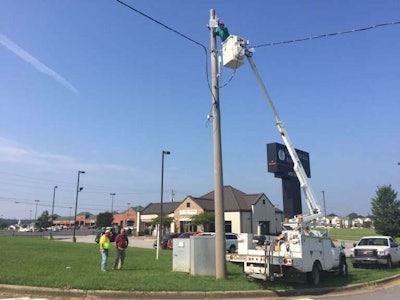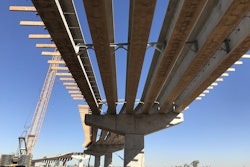 Alabama Department of Transportation, Tuscaloosa Department of Infrastructure and Public Services, and personnel from Temple traffic signal company of Decatur, Alabama, install the first dedicated short-range communication radios in the state. Source: University of Alabama
Alabama Department of Transportation, Tuscaloosa Department of Infrastructure and Public Services, and personnel from Temple traffic signal company of Decatur, Alabama, install the first dedicated short-range communication radios in the state. Source: University of AlabamaThe University of Alabama has teamed up with the Alabama Department of Transportation to install communication radios in traffic signals to collect data that could help reduce crashes and prepare for self-driving vehicles.
The project was inspired by the American Association of State Highway and Transportation Officials’ national challenge to install 20 of the radios – known as dedicated short-range communication radios, or DSRC radios – in every state by 2020.
The university project will involve installing 85 radios in traffic signals throughout Tuscaloosa and Northport, with the first 50 installations scheduled for this fall.
“We expect significant advances in the U.S. transportation system during the next 10 years, made possible through many of the technologies currently being tested in Alabama,” said Dr. Bharat Balasubramanian, executive director of the university’s Center for Advanced Vehicle Technologies. “Some of the benefits we will see from these advances are improved safety, optimized traffic flow and better fuel economy.”
Researchers believe the radios could provide red light warnings to vehicles, similar to crash warnings. Such technology in vehicles could be available in the next 10 years, according to a University of Alabama news release.
“Initially, the units will be set up to send information only from infrastructure to vehicles, and not yet from vehicles to infrastructure,” the release says. “DSRC units are unable and not designed to retain or gather any personal information.”
The information gathered through the system will allow faculty, staff and students “to study signal phase and timing data,” according to the release. “These studies will lead to greater interaction between vehicles and traffic signals to communicate information like road conditions or changing signals.”
Along with ADOT, the university is working on the project with local, state and federal agencies, as well as automotive manufacturers.










